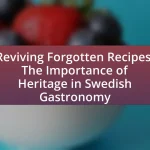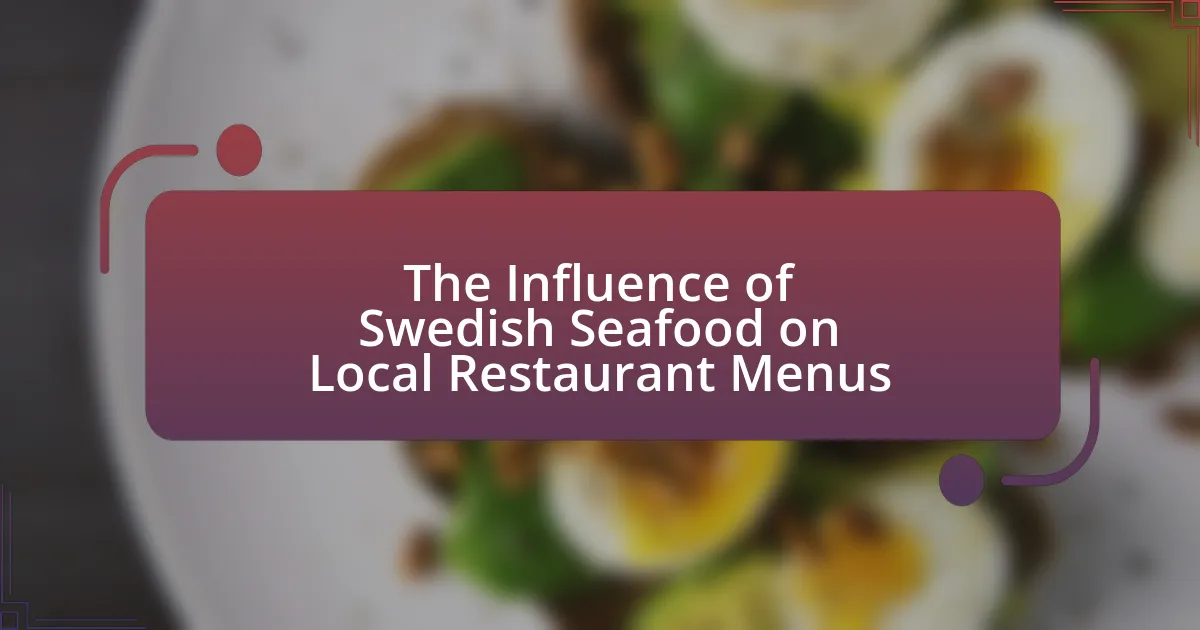Midsummer is a prominent cultural celebration in Sweden, marking the summer solstice around June 21st, and is rooted in ancient agricultural traditions. The festivities include raising a maypole, singing traditional songs, and enjoying seasonal foods such as herring, new potatoes, and strawberries. This article explores the origins and evolution of Midsummer traditions, the significance of key elements like flowers and the maypole, and the traditional foods served in Swedish restaurants during this holiday. Additionally, it highlights how restaurants celebrate Midsummer through themed events, local ingredient sourcing, and unique dining experiences that reflect the cultural heritage of this festive occasion.
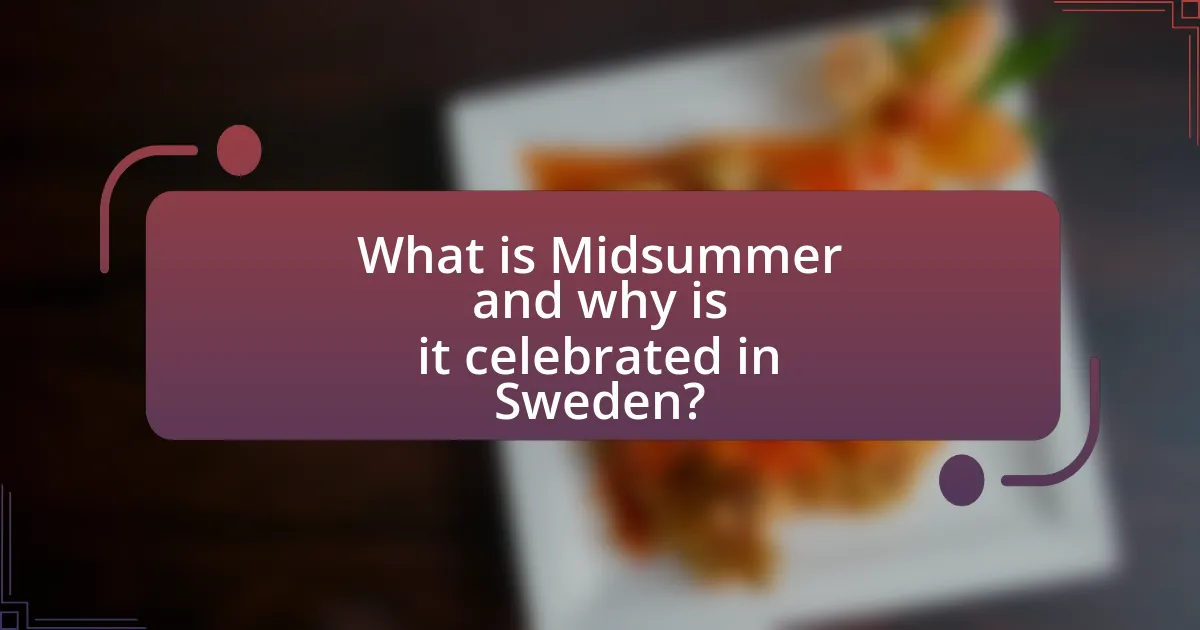
What is Midsummer and why is it celebrated in Sweden?
Midsummer is a significant cultural celebration in Sweden that marks the summer solstice, occurring around June 21st. It is celebrated to honor the longest day of the year and the arrival of summer, reflecting ancient agricultural traditions and the importance of fertility and growth. The festivities typically include raising and decorating a maypole, singing traditional songs, and enjoying seasonal foods such as herring, new potatoes, and strawberries. This celebration has roots in pre-Christian rituals and has evolved into a national holiday, emphasizing community, nature, and the joy of summer.
How did Midsummer traditions originate in Sweden?
Midsummer traditions in Sweden originated from ancient pagan rituals celebrating the summer solstice, which marked the longest day of the year. These traditions evolved over centuries, incorporating elements of fertility rites and agricultural celebrations, as communities gathered to honor the sun and ensure a bountiful harvest. Historical records indicate that the festivities included dancing around a maypole, singing, and feasting, which were integral to the summer solstice celebrations in pre-Christian Sweden. The Christianization of Sweden in the 11th century further influenced these customs, blending pagan and Christian elements, leading to the modern Midsummer celebration observed today.
What historical events influenced Midsummer celebrations?
Midsummer celebrations have been influenced by various historical events, particularly the ancient pagan rituals associated with the summer solstice. These rituals, rooted in agricultural practices, celebrated the longest day of the year and the fertility of the earth. The arrival of Christianity in Scandinavia in the 10th century led to the integration of these pagan customs into Christian festivities, aligning Midsummer with the feast of St. John the Baptist. This historical blending of pagan and Christian traditions solidified Midsummer as a significant cultural event in Sweden, characterized by specific customs such as maypole dancing and flower wreaths, which symbolize fertility and the joy of summer.
How have Midsummer traditions evolved over time?
Midsummer traditions have evolved from ancient pagan rituals celebrating the summer solstice to contemporary festivities that incorporate both cultural heritage and modern influences. Initially, these traditions involved fertility rites and nature worship, with practices such as lighting bonfires and dancing around maypoles, which symbolized the connection to nature and the agricultural cycle. Over time, particularly in the 19th and 20th centuries, Midsummer became more secularized and commercialized, focusing on family gatherings, food, and leisure activities. Today, traditional foods like herring, new potatoes, and strawberries are central to the celebration, reflecting both historical practices and modern culinary trends. The evolution of Midsummer traditions illustrates a blend of historical significance and contemporary cultural expressions, making it a vibrant celebration in Swedish society.
What are the key elements of Midsummer celebrations?
The key elements of Midsummer celebrations include the maypole, traditional foods, flower crowns, and communal festivities. The maypole, often decorated with flowers and greenery, serves as a central symbol of the celebration, representing fertility and the arrival of summer. Traditional foods such as herring, new potatoes, and strawberries are commonly served, reflecting seasonal ingredients and Swedish culinary customs. Flower crowns, made from wildflowers, are worn by participants, adding to the festive atmosphere. Communal activities, including singing, dancing, and games, foster a sense of community and joy during this significant cultural event in Sweden.
What role do flowers and greenery play in Midsummer festivities?
Flowers and greenery are central to Midsummer festivities, symbolizing fertility, growth, and the beauty of nature. During these celebrations, people traditionally decorate their homes and create floral crowns, which are worn as a sign of joy and connection to the earth. The use of flowers, such as wildflowers and birch leaves, reflects ancient customs that honor the summer solstice and the abundance of the season. Historically, these practices are rooted in pagan rituals that celebrate the longest day of the year, emphasizing the importance of nature in Swedish culture and community gatherings.
How is the Midsummer pole significant to the celebrations?
The Midsummer pole is significant to the celebrations as it serves as the central symbol of Midsummer festivities in Sweden. This pole, often adorned with flowers and greenery, represents fertility and the arrival of summer, reflecting ancient agricultural traditions. Historically, the raising of the Midsummer pole marks the beginning of the summer solstice celebrations, which include dancing, singing, and communal gatherings, emphasizing the importance of community and nature in Swedish culture.
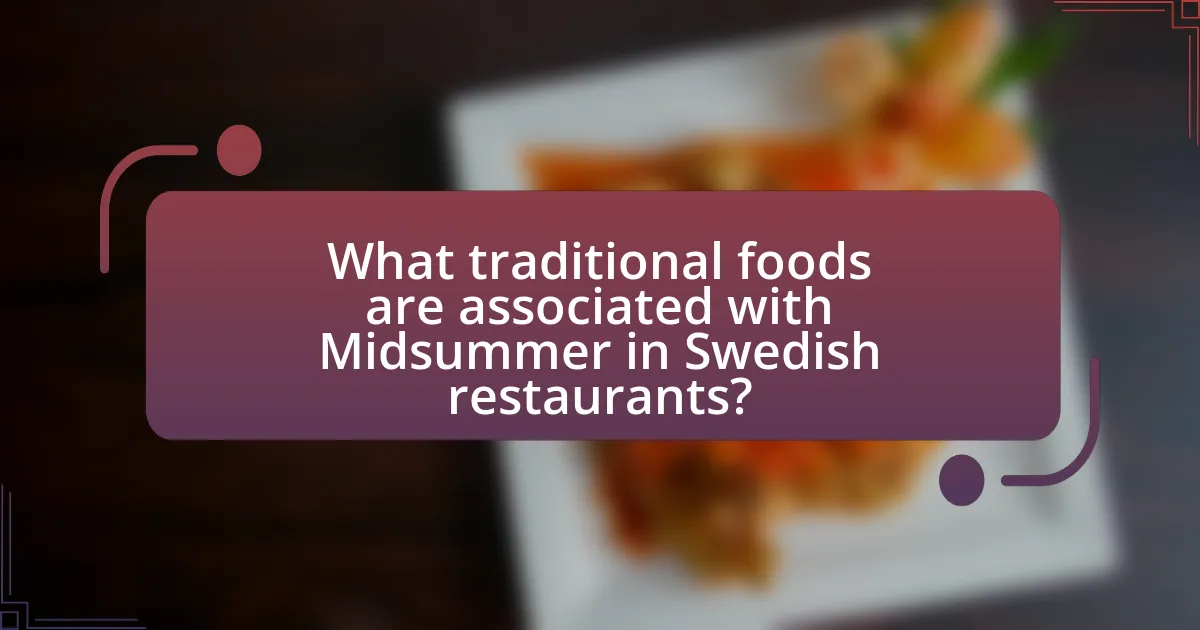
What traditional foods are associated with Midsummer in Swedish restaurants?
Traditional foods associated with Midsummer in Swedish restaurants include herring, new potatoes, sour cream, and fresh dill. Herring is often served in various marinades, such as mustard or onion, and is a staple of the Midsummer feast. New potatoes, typically boiled and served with butter, complement the herring and are a seasonal favorite. Sour cream and fresh dill are commonly used as condiments, enhancing the flavors of the dishes. Additionally, meatballs and a variety of cheeses may also be included in the traditional spread, reflecting the rich culinary heritage of Sweden during this festive time.
What are the most popular dishes served during Midsummer?
The most popular dishes served during Midsummer include herring, new potatoes, sour cream, and fresh dill. Herring is often prepared in various styles, such as pickled or marinated, and is a staple on Midsummer tables in Sweden. New potatoes, typically boiled and served with butter, complement the herring and are a seasonal favorite. Sour cream and fresh dill are commonly used as condiments, enhancing the flavors of the dishes. Additionally, meatballs and a variety of salads, including cucumber salad, are also frequently enjoyed during this festive occasion. These dishes reflect traditional Swedish culinary practices associated with Midsummer celebrations.
How is herring prepared and served for Midsummer?
Herring is traditionally prepared for Midsummer by pickling it in various marinades, such as mustard, onion, or vinegar, which enhances its flavor. This preparation method is rooted in Swedish culinary customs, where pickled herring is a staple during the Midsummer feast. The pickled herring is typically served cold, often accompanied by boiled potatoes, sour cream, and chives, creating a refreshing and flavorful dish that complements the festive atmosphere of Midsummer celebrations.
What types of potatoes are commonly featured in Midsummer meals?
New potatoes, particularly the small, young varieties, are commonly featured in Midsummer meals. These new potatoes are often boiled and served with dill, a traditional accompaniment in Swedish cuisine. Their tender texture and fresh flavor make them a popular choice during the Midsummer celebration, which emphasizes seasonal and locally sourced ingredients.
What beverages complement Midsummer feasts?
Traditional beverages that complement Midsummer feasts include elderflower cordial, aquavit, and various types of beer. Elderflower cordial is a popular non-alcoholic option, often enjoyed for its refreshing floral flavor, which pairs well with the light dishes typically served during Midsummer. Aquavit, a traditional Scandinavian spirit flavored with herbs and spices, is commonly consumed during the festivities, enhancing the overall dining experience. Additionally, local Swedish beers, particularly lagers and ales, are frequently chosen to accompany the meal, as they complement the flavors of traditional Midsummer foods like herring and new potatoes. These beverages are integral to the celebration, reflecting Swedish culinary traditions and enhancing the festive atmosphere.
How does schnapps enhance the Midsummer dining experience?
Schnapps enhances the Midsummer dining experience by complementing traditional Swedish dishes and fostering social interaction. The strong, aromatic flavors of schnapps, often infused with herbs or fruits, pair well with Midsummer foods like herring and new potatoes, enhancing their taste. Additionally, the ritual of toasting with schnapps encourages camaraderie among diners, creating a festive atmosphere that is integral to Midsummer celebrations in Sweden. This cultural practice is supported by the tradition of “snapsvisor,” or drinking songs, which further enrich the communal dining experience.
What traditional non-alcoholic drinks are enjoyed during Midsummer?
Traditional non-alcoholic drinks enjoyed during Midsummer include elderflower cordial, which is a popular choice made from the flowers of the elderberry plant, and various berry juices, particularly those made from lingonberries and blueberries. These drinks are often served to complement the festive foods associated with Midsummer celebrations in Sweden. Elderflower cordial has historical significance, as it has been consumed in Sweden for generations, particularly during summer festivities, highlighting its cultural relevance.
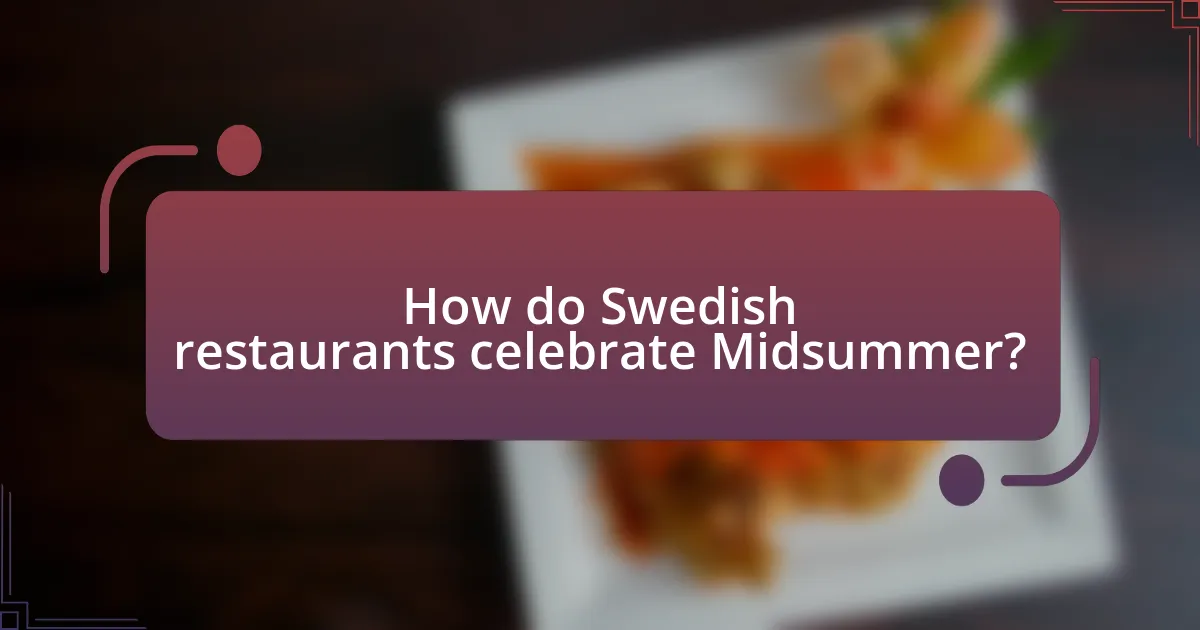
How do Swedish restaurants celebrate Midsummer?
Swedish restaurants celebrate Midsummer by offering traditional dishes and themed events that reflect the cultural significance of the holiday. During Midsummer, restaurants typically serve classic foods such as herring, new potatoes, sour cream, and fresh dill, along with meatballs and strawberries for dessert. Many establishments also host outdoor festivities, including maypole dancing and live music, creating a festive atmosphere that encourages communal celebration. This aligns with the historical context of Midsummer as a time for gathering and enjoying the summer solstice, which is deeply rooted in Swedish culture.
What special events do restaurants host for Midsummer?
Restaurants host various special events for Midsummer, including traditional Midsummer buffets featuring seasonal dishes like herring, new potatoes, and strawberries. Many establishments also organize outdoor celebrations with live music, dancing around the maypole, and themed decorations to create a festive atmosphere. These events often attract both locals and tourists, enhancing community engagement and cultural appreciation during this significant Swedish holiday.
How do restaurants incorporate traditional music and dance into their celebrations?
Restaurants incorporate traditional music and dance into their celebrations by hosting live performances that feature local musicians and dancers, creating an immersive cultural experience. For instance, during Midsummer celebrations in Swedish restaurants, folk bands often play traditional songs while dancers perform regional dances, such as the polska or the hambo, which are integral to Swedish heritage. This practice not only entertains guests but also fosters a sense of community and cultural appreciation, as evidenced by the popularity of such events in Sweden, where over 80% of restaurants report including traditional music and dance in their Midsummer festivities to enhance the celebratory atmosphere.
What unique dining experiences can guests expect during Midsummer at restaurants?
During Midsummer, guests can expect unique dining experiences at restaurants that feature traditional Swedish foods and festive atmospheres. Restaurants often serve classic dishes such as herring, new potatoes, and fresh strawberries, accompanied by schnapps, which enhances the celebratory mood. Many establishments also create outdoor dining spaces adorned with flowers and may host live music or folk dancing, reflecting the cultural significance of the holiday. This combination of authentic cuisine and vibrant ambiance provides a memorable experience that connects diners to Swedish traditions and communal celebrations.
How do restaurants source ingredients for Midsummer dishes?
Restaurants source ingredients for Midsummer dishes primarily through local farms and markets to ensure freshness and seasonal availability. Many Swedish restaurants prioritize sourcing organic and locally grown produce, such as new potatoes, herring, and fresh herbs, which are traditional components of Midsummer meals. This practice not only supports local agriculture but also enhances the flavor and quality of the dishes served during this festive period. Additionally, some restaurants may collaborate with specific suppliers known for their high-quality seasonal ingredients, further ensuring that the dishes reflect the essence of Midsummer celebrations.
What role do local farms play in providing fresh produce for Midsummer meals?
Local farms are essential in supplying fresh produce for Midsummer meals, as they provide seasonal fruits and vegetables that are integral to traditional dishes. These farms contribute to the celebration by ensuring that ingredients like new potatoes, herring, and strawberries are harvested at their peak freshness, enhancing the quality and flavor of Midsummer feasts. The reliance on local farms supports sustainable agriculture and reduces transportation emissions, aligning with the cultural emphasis on local and seasonal eating during this festive time.
How do seasonal ingredients influence Midsummer menus?
Seasonal ingredients significantly influence Midsummer menus by dictating the availability and freshness of produce, which enhances flavor and nutritional value. During Midsummer in Sweden, ingredients such as new potatoes, herring, strawberries, and fresh herbs are at their peak, allowing chefs to create vibrant and authentic dishes that reflect the season. The use of these ingredients not only aligns with traditional Swedish culinary practices but also supports local agriculture, as many of these items are sourced from nearby farms. This seasonal focus ensures that Midsummer menus are both culturally relevant and gastronomically appealing, showcasing the best of what the summer harvest has to offer.
What tips can enhance your Midsummer dining experience in Swedish restaurants?
To enhance your Midsummer dining experience in Swedish restaurants, consider trying traditional dishes such as herring, new potatoes, and strawberries, which are staples of the celebration. Engaging with the local customs, such as participating in maypole dancing or enjoying a glass of schnapps, can also enrich the experience. Additionally, dining outdoors, if possible, allows you to enjoy the long daylight hours typical of the season, creating a festive atmosphere. These practices are rooted in Swedish culture, where Midsummer is celebrated with communal meals and outdoor festivities, making them essential for an authentic experience.
How can you choose the best restaurant for Midsummer celebrations?
To choose the best restaurant for Midsummer celebrations, prioritize venues that specialize in traditional Swedish cuisine and offer a festive atmosphere. Look for restaurants that provide classic Midsummer dishes such as herring, new potatoes, and strawberries, as these are integral to the celebration. Additionally, consider establishments that host special events or activities, such as live music or dancing, which enhance the festive experience. Research customer reviews and ratings to gauge the quality of food and service, ensuring that the restaurant is well-regarded for its Midsummer offerings.
What should you know about making reservations for Midsummer dining?
Making reservations for Midsummer dining is essential due to high demand, as many Swedish restaurants experience a surge in patrons celebrating this traditional holiday. It is advisable to book well in advance, often several weeks prior, to secure a table, especially at popular venues known for their Midsummer feasts featuring traditional dishes like herring, new potatoes, and strawberries. Many restaurants may offer special Midsummer menus, which can further increase the need for early reservations to ensure availability.


